Even More True Tales of Tribeca Buildings
The History of Tribeca Buildings database—compiled from Tom Miller’s posts at Daytonian in Manhattan—has six more entries on the properties below. (Click the address to read the full text.) If you enjoy these, and you will, then you should definitely check out his website, which also has write-ups about buildings all over the island. And don’t miss his book, Seeking New York: The Stories Behind the Historic Architecture of Manhattan—One Building at a Time.
······················
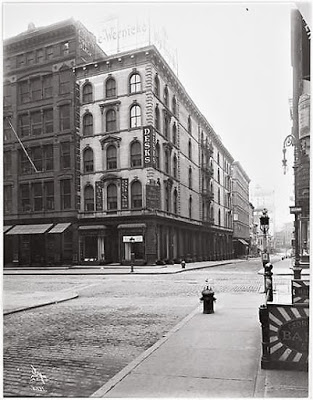 380 BROADWAY
380 BROADWAY
In 1859, financiers Samuel D. Babcock and Matthew Morgan began construction on a handsome commercial structure at the northeast corner of Broadway and White Street. Completed in 1860, the Italianate style building was elegantly faced in white marble and stretched approximately 71 feet along Broadway and 175 down White Street. The structure was, in fact, two buildings. No. 380-382 was separated from 384-386 by a brick firewall—one that would prove its importance later. [Nowadays] few passersby would suspect that the handsome marble building is a sliver of its original self. (1919 photo by Byron Company from the collection of the Museum of the City of New York.)
······················
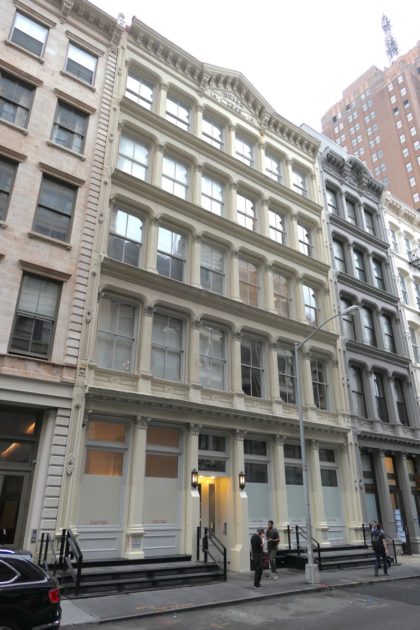 46-48 LISPENARD
46-48 LISPENARD
In 1846, Daniel D. Badger moved to New York City with his innovative concept of prefabricated cast-iron facades. The idea caught on—especially in the districts that would be later called Soho and Tribeca where commercial buildings were rapidly taking the place of three-story brick houses. Among the architects who embraced cast iron was Isaac F. Duckworth. Duckworth was prolific in the downtown area, sometimes acting as both architect and developer. He was commissioned in 1866 by Pierre Keff Francis (who by now had Anglicized his name in directories as Peter) to design a five-story loft building on the site of the two three-story structures at Nos. 46 and 48 Lispenard Street. […] Daniel Badger’s Architectural Iron Works manufactured the facade for the French Second Empire style structure. Unlike some of the elaborate examples pictured in the firm’s 1865 catalogue, Duckworth had designed a comparatively no-nonsense series of flat-arched openings separated by Corinthian pilasters. Handsome paneled end piers added visual interest. It was the robust bracketed cornice that stood out. Here cast lettering announced the construction date within the pediment. On a side note, when Duckworth was hired later that same year to design a building for Daniel C. Kingsland around the corner at Nos. 315-317 Church Street, he may have pitched a cost-savings idea. By re-using the foundry molds, Kingsland would save considerable money. Whether or not that was the motivation, that building, completed in 1869, is a duplicate of the Lispenard Street structure.
······················
 400 BROADWAY
400 BROADWAY
Among Augustus Hemenway’s earliest tenants was Charles Richlos. After leaving work on the evening of June 11, 1865, the wealthy businessman allowed his carnal passions to get the better of his common sense. He ran into two women on the street who lured him into a saloon. Their intentions were not romantic. The New York Times reported on July 4, “It appears that [Francisca] Alreary and one Margaret Early induced Mr. Richlos to enter a Grand-street den… and drugged him there with pothouse wine.” When Richlos regained his senses, he found that his “gold watch, chain, seal, breastpin and hat” were missing. Francisca Alreary was found and arrested. At the time of the article Margaret Early was still at large. (Photo circa 1939 from the collection of the New York Public Library.)
······················
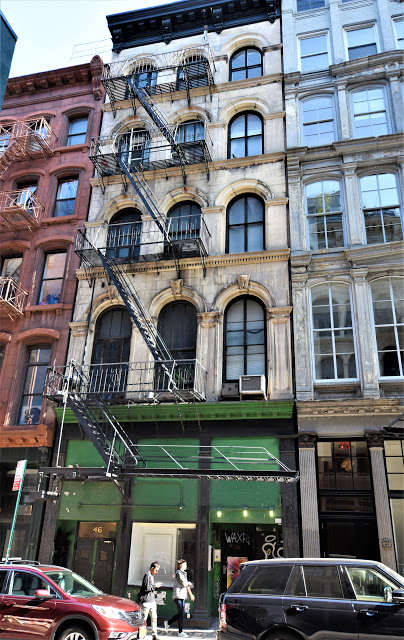 46 WALKER
46 WALKER
John LeConte’s first tenant was the publishing firm of W. A. Townsend & Co. The company walked a thin line in September, 1859, when it introduced Out of the Depths: The Story of a Woman’s Life. The subject matter—a prostitute who struggled to regain respectability—was so controversial that the author remained anonymous. The reviews were carefully worded. The New York Courier said in part, “The story is well told, and though the reader is taken through scenes which may sometimes startle, still there is nothing told that is offensive. The object of the writer is most commendable.” The New-York Express was positive that the author could only have been a man, “for a lady could hardly be so conversant with the phases of life described.” And The Boston Atlas wavered as to whether the book would dissuade young women from becoming “degraded,” or tempt them “to try by such exposure.” The critic concluded, “We… believe that its perusal ought to do good rather than mischief.”
······················
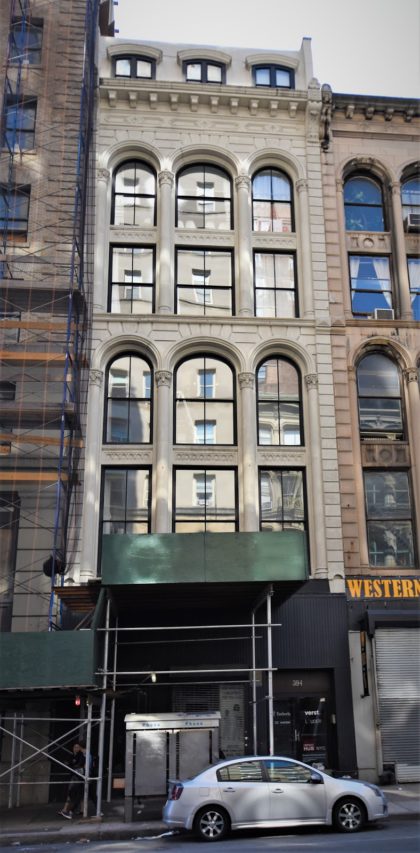 394 BROADWAY
394 BROADWAY
In 1914, the Frank Tourist Co., what today would be termed a travel agency, was in the building. The office specialized in vacation tours. That year it offered tours to the White Mountains, Yellowstone Park, Glacier National Park, and Lakes George and Champlain, among many others. A one-week tour the Adirondack Mountains cost $46; while a 27-day tour in California was $145.50.
······················
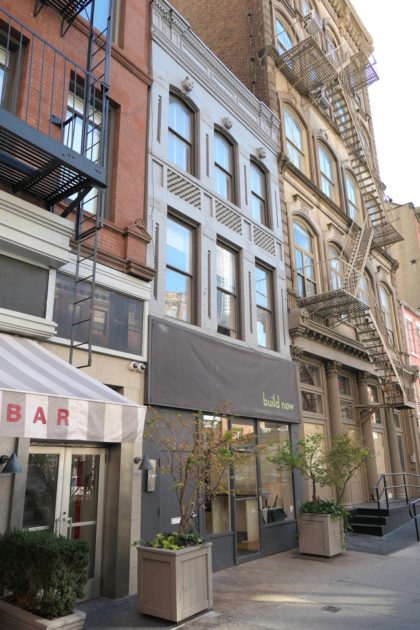 141 W. BROADWAY
141 W. BROADWAY
Declared insane by the courts—he was diagnosed with paresis, a form of dementia often caused by advanced syphilis—Philip McDowell was committed and his brother took over the management of his estate, including the Foghorn Tavern and the South Fifth Avenue building. Philip McDowell’s stay in the insane asylum would not be especially long. He died on October 4, 1894. The many friends and politicians present during the funeral were no doubt shocked five months later when Agnes N. McDowell sued to have James McDowell removed as administrator of his brother’s estate. She claimed to be the wife of Philip McDowell. She told the court on March 27, 1895, “that James McDowell has known for years that she was the wife of his brother.” The enterprising woman managed only to hold up the process and in the end James inherited his brother’s entire estate. […] As had been the case with his brother, James McDowell’s friends and business associates would get a major shock following his death in June 1903. The Evening World reported “a woman claiming to be his widow appeared at his funeral, and that was the first his host of friends ever knew of his marriage.” But unlike Agnes N. McDowell’s attempted scam, Elizabeth McDowell’s story was true.
······················
















What happened to that nice looking building next to 400 Broadway? Why and when was it demolished? It is now replaced by 3 ugly low rise building 402-406 Broadway that should be gone like yesterday!
I love Daytonian in Manhattan and look forward to each new post. always informative and fascinating!
The McDowells — a fascinating story but what has it to do with 141 West Broadway? Was it the site of the Foghorn Tavern? And why does anyone know why the third floor windows have those animal faces? I remember when it was a kind of pet shop specializing in birds (Treflich’s was it?)